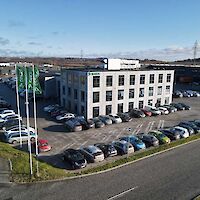The six DEKRA Regions & the
Sustainability Lighthouse Locations
The DEKRA Lighthouse Location project
Already launched in 2020, the DEKRA Lighthouse Project is a forward-looking initiative that aims to establish sustainable DEKRA flagship locations worldwide. This project is part of DEKRA's ambitious sustainability targets for 2025, with a focus on reducing the environmental impact of buildings. The “lighthouse sites” are intended to promote DEKRA's commitment to sustainability through visible measures such as the reduction of CO₂ emissions, energy efficiency and biodiversity. Each region has selected a site to implement these green practices and adapt them to local needs. The project not only strives for CO₂ neutrality or CO₂-positive operations, but also promotes sustainable practices as a model for future DEKRA sites worldwide.
Regional Lighthouse Locations
-
APAC - New Zealand: Te Rapa and Tauranga
 At DEKRA’s Lighthouse sites in New Zealand, located in Te Rapa and Tauranga, the focus is on maximizing energy efficiency and renewable energy use. Both sites feature high-efficiency monocrystalline PV panels generating 27.73 kWp each, along with LED lighting for interiors and exteriors. Tauranga also benefits from natural light via translucent skylights. Energy-efficient heat pumps manage temperature control, while digital monitoring tracks energy usage. The sites are aligned with New Zealand’s largely renewable energy grid and aim to achieve 100% green power. Efforts to support biodiversity include native tree planting, with plans for an insect hotel and rainwater reuse.
At DEKRA’s Lighthouse sites in New Zealand, located in Te Rapa and Tauranga, the focus is on maximizing energy efficiency and renewable energy use. Both sites feature high-efficiency monocrystalline PV panels generating 27.73 kWp each, along with LED lighting for interiors and exteriors. Tauranga also benefits from natural light via translucent skylights. Energy-efficient heat pumps manage temperature control, while digital monitoring tracks energy usage. The sites are aligned with New Zealand’s largely renewable energy grid and aim to achieve 100% green power. Efforts to support biodiversity include native tree planting, with plans for an insect hotel and rainwater reuse. -
GSA - Germany: Ingolstadt & Wart Congress Center
 Germany’s Lighthouse locations combine sustainable construction and biodiversity. Ingolstadt's new site incorporates KfW40-rated insulation, rooftop PV panels, and a reversible heat pump. The Wart Congress Center emphasizes renewable energy and sustainable services, with PV panels, EV charging stations, and a commitment to regional food sourcing and waste reduction. You can find out more here.
Germany’s Lighthouse locations combine sustainable construction and biodiversity. Ingolstadt's new site incorporates KfW40-rated insulation, rooftop PV panels, and a reversible heat pump. The Wart Congress Center emphasizes renewable energy and sustainable services, with PV panels, EV charging stations, and a commitment to regional food sourcing and waste reduction. You can find out more here. -
NWE – Denmark: Brabrand
 DEKRA’s Lighthouse site in Brabrand, Denmark, is setting new standards for energy self-sufficiency and biodiversity. The building, completed in 2022, was designed to be as self-sufficient as possible in terms of energy supply. Photovoltaic (PV) modules covering the maximum roof area, with a planned total production of 118 MWh annually, will provide renewable energy. Additionally, two Vertical Axis Wind Turbines (VAWT) are planned, though their installation is pending final municipal approval. An innovative energy storage solution is also under evaluation: surplus energy from the PV system could be stored as hydrogen, with an estimated annual production of 690 kg for own training vehicle use. Heat generated during the hydrogen electrolysis process will be channeled directly into the local district heating network, further reducing heating demand.
DEKRA’s Lighthouse site in Brabrand, Denmark, is setting new standards for energy self-sufficiency and biodiversity. The building, completed in 2022, was designed to be as self-sufficient as possible in terms of energy supply. Photovoltaic (PV) modules covering the maximum roof area, with a planned total production of 118 MWh annually, will provide renewable energy. Additionally, two Vertical Axis Wind Turbines (VAWT) are planned, though their installation is pending final municipal approval. An innovative energy storage solution is also under evaluation: surplus energy from the PV system could be stored as hydrogen, with an estimated annual production of 690 kg for own training vehicle use. Heat generated during the hydrogen electrolysis process will be channeled directly into the local district heating network, further reducing heating demand.Promoting alternative mobility is also a priority. Along with 12 electric charging stations for cars, the site has already installed four charging stations for heavy electric vehicles, including trucks and buses, with additional charging points for electric trucks under consideration.
To support biodiversity, several initiatives have been implemented: the building façade features a climbing structure to support greenery, an insect hotel shaped as the DEKRA “D,” crafted from recycled aluminum and natural materials, has been installed on site and the greenery concept is extended indoors, with vertical planters added to the common areas.
To ensure long-term sustainability, the site aims to achieve DGNB certification for “Buildings in Use.” In line with this goal, processes are being developed for continuous improvement in energy, water, and waste management, positioning this location as a model for sustainable construction and operations.
-
SWE - France: Lyon
 The lighthouse project near Lyon represents SWE’s commitment to eco-conscious construction. This new facility will feature sustainable materials, sun-shading elements, and low-carbon wood construction, aiming for a BEPOS positive energy certification. Photovoltaic systems will cover a bike room and vehicle charging stations, while mineral parking areas and strategic tree planting enhance natural aesthetics and thermal efficiency. The facility is designed for employee wellbeing and alternative transportation access.
The lighthouse project near Lyon represents SWE’s commitment to eco-conscious construction. This new facility will feature sustainable materials, sun-shading elements, and low-carbon wood construction, aiming for a BEPOS positive energy certification. Photovoltaic systems will cover a bike room and vehicle charging stations, while mineral parking areas and strategic tree planting enhance natural aesthetics and thermal efficiency. The facility is designed for employee wellbeing and alternative transportation access. -
AMERICAS – USA: Sterling and Plymouth
 Despite challenges of rented premises, DEKRA’s Sterling, Virginia location has adopted full LED lighting and improved waste management, with a green electricity contract to cut emissions. In Plymouth, Michigan, DEKRA’s new laboratory acquisition opens up further possibilities for sustainable investments, focusing on energy efficiency for its high-demand operational needs.
Despite challenges of rented premises, DEKRA’s Sterling, Virginia location has adopted full LED lighting and improved waste management, with a green electricity contract to cut emissions. In Plymouth, Michigan, DEKRA’s new laboratory acquisition opens up further possibilities for sustainable investments, focusing on energy efficiency for its high-demand operational needs. -
CEEME – Italy: Milan
 In Milan, DEKRA’s CEEME Lighthouse site combines partial timber use with greenery elements on its new PTI station’s façade. Once permits are obtained, the site will feature rooftop PV panels and environmentally-friendly design aspects. This project underscores DEKRA’s dedication to integrating sustainable materials and renewable energy even in high-traffic inspection facilities.
In Milan, DEKRA’s CEEME Lighthouse site combines partial timber use with greenery elements on its new PTI station’s façade. Once permits are obtained, the site will feature rooftop PV panels and environmentally-friendly design aspects. This project underscores DEKRA’s dedication to integrating sustainable materials and renewable energy even in high-traffic inspection facilities.


















































